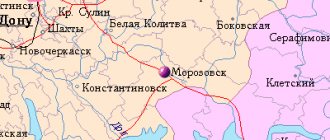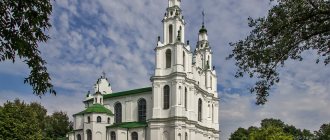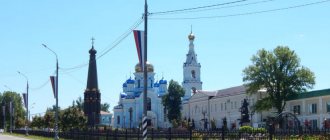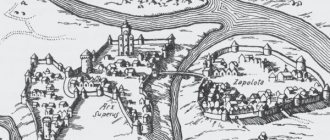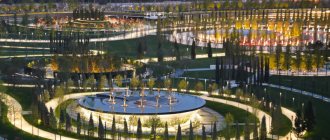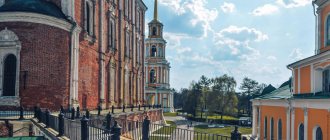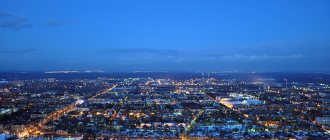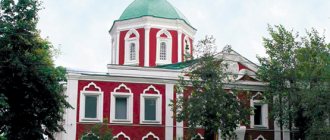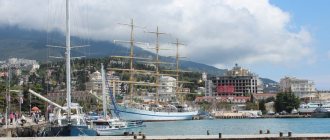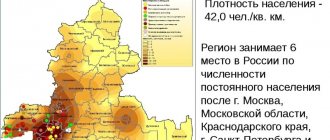The most interesting places in the Rostov region - TOP-3
A great number of natural monuments and reserves are registered on Rostov soil. Every tourist should see the most impressive creations of nature.
Biosphere Reserve "Rostovsky"
- Coordinates on the map: 46.464722, 43.050556.
The main natural reserve of the region has the status of a reserve of federal significance and covers the territory of the Remontnensky and Oryol districts, which is about 9,500 hectares. Most of the reserve, founded at the end of 1995, is occupied by endless desert steppes with saline soil, so the local flora is resistant to salts. The flora includes more than 400 species, 6 of which are included in the Red Book of Russia and another ten are listed in the Red Book of the region.
Many insects flock to the fragrant plants, including such rare species as the steppe bumblebee, Hungarian ground beetle and Bolivaria short-winged. Numerous birds nest near the river, including endangered species.
Wolves and foxes prowl along the valley steppes of the Manych River, horned saigas and delightful Manych mustangs gallop. In the grass you can see nimble field rodents, hares and hedgehogs. Tourists should be careful: there are a lot of snakes crawling on the ground, most of them are non-poisonous, but quite aggressive. Feeling a threat, reptiles can attack a person and bite the skin until they bleed.
Mountains Two Sisters
- GPS coordinates: 48.120571, 40.733055.
The two peaks are not the only mountains on the shore of the Northern Donets, but they stand out among their neighbors due to their height and extraordinary similarity to each other. Many people note that the twin mountains look like gigantic reptiles. It’s as if two huge lizards with protruding stone ridges have crawled to a watering hole and are lying side by side, with their heads directed towards the river.
The area has long been overgrown with myths and legends; the most famous one says that the peaks are enchanted sisters. Scientists give a very specific and realistic explanation for the natural phenomenon.
The hundred-meter-high mountains were formed about a million years ago as a result of the movement of the earth’s crust, when giant layers of limestone rose to the surface of the earth and over time became overgrown with greenery. Today, a floodplain forest separates the mountains at the foot, and clean freshwater springs rustle among the trees.
Long, or Long Canyon
- Coordinates: 48.228853, 40.349719.
A delightful canyon in the Kamensky district is a piece of the North American landscape in the middle of the steppe of the Rostov region. At the foot of the cliff flows an azure river, whose waters are so clean and transparent that through them you can see almost every pebble at the bottom.
Oddly enough, this amazing attraction appeared only in the last century and partly due to the fault of man. During Soviet times, there was a quarry here where stone was mined for construction work.
One day the quarry began to fill with groundwater and the huge pit was flooded to the very top in a matter of hours. Some of the equipment remained under water, which they did not have time to lift to a higher ground. The river is still fed by underground springs, so its waters remain cold even in hot weather.
Merzhanovsky lighthouse
- Address: Merzhanovo village, Neklinovsky district.
Not far from Taganrog, near the village of Merzhanovo, there is this man-made landmark of the Rostov region, which appeared relatively recently - as a set for the film “The Lighthouse Keeper”. Today, tourists happily visit this exciting place, mentally immersing itself in the distant past.
Loga Park
- Address: Loga Park, village. Staraya Stanitsa
In the area of the village of Staraya Stanitsa, near Kamensk-Shakhtinsky, there is Loga Park, where visitors can enjoy a lot of interesting entertainment and attractions, including the most popular - Crooked Mirrors. This place was included in our rating because it is truly unique - there are only a few like it in all of Russia. As the reviews say, when you relax here, you relax your soul!
Southern Bird Park "Malinki"
- Address: Krasny Sulin, PSH Sokolovskoye.
An interesting recreation park of regional significance is located near Novoshakhtinsk. “Malinka” itself will delight you with a unique “collection” of birds that you can see with the whole family. The territory is well designed, there is a lot of interesting things here, there are gazebos and bungalows near the shore of a neighboring reservoir, and beaches.
Rostov region: the most beautiful nature reserves
The main task of the Rostov nature reserves is to preserve and replenish the unique nature of the steppes and rare forests. In many protected areas, conditions have been created for recreation, fishing and hunting.
Natural Park "Donskoy"
- Coordinates: 47.184838, 39.285030.
The extensive natural park was founded in 2005, when it included four districts of the region with a total area of more than 40,000 hectares. The protected land is divided into two unequal sections: the large “Don Delta” and the smaller “Ostrovny”.
The fauna and flora of the first section are immensely rich even in comparison with the deltas of other large rivers; in the protected area there are more than 1000 species of birds, mammals and insects and more than 800 species of plants.
In addition to scientific and environmental activities, ecotourism is actively developing in the park; ecological trails and routes are being developed for guests of the reserve.
Mukhina beam
- Coordinates: 47.271565, 39.887148.
The large ravine in the vicinity of Aksai is a nature reserve and one of the most beautiful and mysterious places in the Rostov region. The area received its first name – Small Log – back in the 18th century. Later the log was renamed Ryabinovaya Balka.
Years later, the territory passed into the possession of the Mukhins, timber merchants, and the beam received the name of the new owners. The slopes of the ravine are covered with trees, as well as medicinal herbs and steppe plants, such as dandelion, feather grass, plantain, bluegrass, fescue, wormwood, etc. The bottom of the ravine is hidden under the dark waters of the swamps.
There is an unusual place in the beam that deserves special attention. Black holes gape on the bare sandy slope - entrances to underground tunnels. It is still unknown who created these caves; it is believed that the underground passages served as a refuge for the Cossacks. A little further away there is a museum of military equipment. An exhibition of tanks, armored personnel carriers and other vehicles was located right in the open air.
Despite its environmental status, the reserve suffers more and more from human activity every year. Forests and swamps are polluted, more and more plots of land are being given over to development.
Ilyichevskoe tract
- Coordinates: 47.133333, 42.611944.
Forest is a rare phenomenon for the Rostov region, so it is not surprising that the forest area near the Ilyichev farm received the status of a botanical monument. The tract is relatively small, its area is only 145 hectares. It came under state protection in 1985. It is home to dozens of bird species:
- pheasant and black kite,
- little bustard and eagle owl,
- owl and woodpecker,
- gray partridge and hawk,
- warbler and magpie,
- tit and many others.
The reserve is home to large populations of wild boars, roe deer and sika deer; large herbivores are hunted by local predators - jackals and wolves. The latter are found in three types - black, red and brown.
In 2002, an enclosure for breeding wild boars was built in the tract, and two years later new piglets appeared in the forest. Local specialists also work with other animals; during hungry winters, people feed roe deer and saigas and try to preserve rare species.
Tsimlyansky reserve
- Coordinates: 47.905000, 42.561389.
The lands from the Tsimlya River up to the Tsimlyansk Reservoir were recognized as protected areas in 1983. A significant part of the territory is covered with sand and looks like a desert. The desert image is complemented by sparse vegetation and snakes crawling along the sand. Nevertheless, the Tsimlyansky reserve boasts a variety of flora and fauna.
Most of the reserve is covered with forests and steppe. Dozens of years ago, experts planted pine trees in the reserve to strengthen the soil. Today, pine forests rustle at the planting site. In total, the reserve has several hundred plant species, of which 29 are listed in the Red Book.
About 230 species of animals, including 140 species of birds, have chosen the territory near the Tsimlyansk Reservoir. Birds hunt fish and nest on the shore. Many birds and insects are on the verge of extinction and are especially protected by the state. Tourists can see such rare species as the bustard and the great bustard, and if they are lucky, they can watch roe deer, deer and elk.
Chernyshevsky Sands
- Coordinates: 49.883333, 41.416667.
The forest tract in the Oblivsky district has been a specially protected area since 1977. The main task of the reserve was to stabilize shifting sands. For this purpose, pine, birch, acacia and other trees were planted on an area of 100 hectares. Today, medicinal herbs grow among the sands and overgrown plantings. Artificial forests have become habitats for hedgehogs, hares, foxes and other animals.
Kuleshovsky reserve
- Coordinates: 47.092726, 39.570996.
A large natural monument near the village of Kuleshovka occupies an area of about 10,000 hectares. The reserve acquired a special status in 1999. The protected lands are of great commercial importance; wheat, sunflowers, and vegetables are grown in the fields; fish, in particular silver carp and carp, are bred in the reservoirs.
Stocked ponds, numerous rivers, lakes and eriks, in turn, attract birds. Mute swan, pine tree, marsh harrier, greylag goose, bittern and many other feathered inhabitants nest on the banks. The most common mammals found on the site are foxes, muskrats, hedgehogs, weasels and hares.
Alexander Forest
- Coordinates on the map: 46.744386, 39.131027.
The Alexandrovsky Reserve, with an area of more than 5,000 hectares, was created in 1884 in the Azov region, one hundred kilometers from Rostov-on-Don. The mixed coniferous-deciduous forest is the habitat of dozens of animal species. In its open spaces one can find a raccoon dog, an owl, a heron, a fox, a hare and many other mammals and birds. Pheasants are bred on a farm in the central part of the reserve, and there is also a special nursery for deer.
During the season, for a certain amount of money you can hunt in the forest, but most tourists come just to admire the wonderful animals. Of particular delight are the red deer, which majestically stride among the trees and bushes, trying not to touch the branches with their luxurious antlers.
The flora of the Alexander Forest is no less diverse and interesting. The most valuable tree in the forest is a spreading oak, whose age exceeded 120 years. At the end of summer and autumn, mushroom pickers flock to the forest for a rich harvest of moss mushrooms, russula and lectinum. Guests of the reserve should be careful, as among the mushrooms there are poisonous ones, and the annoying moose fly often flutters in the air.
Sights of the Rostov region
Sights of the Rostov region. The most important and interesting sights of the Rostov region - photos and videos, descriptions and reviews, location, websites.
- Last minute tours
to Russia
- Fine
Rostov-on-Don, st. Bolshaya Sadovayathe very best
Bolshaya Sadovaya Street Rostov-on-Don
Fine
1 review
Rostov-on-Don, st. Bolshaya Sadovaya
The main street of Rostov-on-Don began to be built up in 1781, although at that time it did not yet have a name. But on the master plan dated 1811, the chain of buildings was already designated as Zagorodnaya Street.
- Taganrog, st. Frunze, 20
the very best
Rafailovich's house in Taganrog
Taganrog, st. Frunze, 20
This mansion is one of the most beautiful and oldest buildings in Taganrog. Built in the 1860s, it is included in the list of cultural heritage sites of the Russian Federation. To this day, the beautifully decorated building gives inspiration to artists.
- Taganrog, st. Port and Greek
the very best
Stone staircase in Taganrog
Taganrog, st. Port and Greek
The stone staircase is a real symbol of Taganrog, a favorite vacation spot for citizens and guests of the city. The staircase has been here for more than a hundred years and has always attracted people. The secret is simple: it itself is a most interesting architectural object.
- Rostov-on-Don
the very best
Liventsovskaya fortress
Rostov-on-Don
Liventsovskaya Fortress - this is the name given to the ruins of the oldest settlements in the Rostov region, dating back to the 18th century BC. e. The settlement was built by the tribes of the Catacomb and Yamnaya culture of the Don, and it is often compared to the famous Troy.
- Taganrog, st. Chekhova, 69
the very best
Museum "Chekhov's House" in Taganrog
Taganrog, st. Chekhova, 69
A very small, neat and modest house, located in the depths of one of the courtyards of the wonderful city of Taganrog, may seem unremarkable at first glance. But, as with many things in our world, which at first seem insignificant.
- Rostov-on-Don, st. Coastal
the very best
Embankment of the Don River
Rostov-on-Don, st. Coastal
The embankment of Rostov-on-Don is named after Fyodor Ushakov. On a fine day, you can enjoy the views of the city from the upper decks of the ships. It is noteworthy that in the mid-19th century the embankment in Rostov-on-Don was built by prisoners and civilian craftsmen.
- Rostov-on-Don, st. Nizhnebulvarnaya, 27
the very best
Paramonov warehouses in Rostov-on-Don
Rostov-on-Don, st. Nizhnebulvarnaya, 27
One of the main attractions of Rostov-on-Don is ruins. But even in such a sad state, the Paramonov warehouses make a strong impression. The walls are made of solid red brick and resemble fortress ruins, and springs flowing everywhere create fantastic waterfalls.
- Great
Rostov-on-Don, st. Stanislavsky, 58
the very best
Cathedral of the Nativity of the Blessed Virgin Mary
Great
1 review
Rostov-on-Don, st. Stanislavsky, 58
The main church of the Rostov diocese is located on Stanislavsky Street, 58. The Cathedral of the Nativity of the Blessed Virgin Mary in the port city of five seas is a small copy of the Moscow Cathedral of Christ the Savior. As in former times, the Central Market operates near it, in the past it was a bazaar.
- Rostov region, Myasnikovsky district, village. Nedvigovka
the very best
Tanais
Rostov region, Myasnikovsky district, village. Nedvigovka
Often, in search of unusual places and new experiences, we are ready to cross more than one border, but a lot of unusual and truly unique attractions are very close by, but we know practically nothing about them and have little interest in them.
- Rostov-on-Don, per. Nakhichevansky, 29
Administrative building of Rostov University
Rostov-on-Don, per.
Nakhichevansky, 29 The threat of the capture of Warsaw by the Germans in 1915 forced the evacuation of university staff and some laboratories from the city. The administration and part of the faculties were located in Rostov-on-Don, in an apartment building completed just before the start of the war. - Azov, st. Moskovskaya, 38
Azov Museum-Reserve
Azov, st.
Moskovskaya, 38 The Museum-Reserve of the city of Azov is included in the list of attractions in Russia that are definitely worth a visit in order to better know the history of your country. The Azov Nature Reserve dates back to 1917, when the first exhibition was presented to the public. - Rostov region, Bataysk, Vostochnoe highway, 7/3
Water park "Don-park"
Rostov region, Bataysk, Vostochnoe shosse, 7/3
Water park "Don-park" is a large water and entertainment complex near Rostov-on-Don, located on the shore of Salt Lake. It was opened in 2014 and in just a couple of years it became a favorite place for Rostovites and city guests for family leisure. - Taganrog, st. Admiral Kruys, 6
Water park "Lazurny" in Taganrog
Taganrog, st.
Admiral Kruys, 6 Taganrog is an ancient Russian port, one of the most beautiful cities in the Rostov region. The light salty breeze and the many entertainments typical of the south here remind you of the sea. But the warm waves of Azov are not the only water fun in these parts. - Rostov region, Neklinovsky district
Beglitsky Spit
Rostov region, Neklinovsky district
The Beglitsky Spit is a shallow part of the Taganrog Bay. It got its name from the village of Beglitsa located next to it. In 1930, a fishing collective farm was founded here, but later fishing was stopped due to shallowing. - Taganrog, Bogudonia
Bogdonia
Taganrog, Bogudonia
Fishermen have long lived in Bogudonia (or in the place where this area is now located). The brave “sea wolves” built houses as and where they had to, so today the area is an interweaving of narrow streets with small houses huddled together. - fabulous
Rostov-on-Don, per. Botanical Descent, 7
Botanical Garden of Southern Federal University
great
1 reviewRostov-on-Don, per. Botanical Descent, 7
In the Don steppes, every tree was always worth its weight in gold. It is not surprising that after the University of Warsaw moved to Rostov-on-Don in 1915, a botanical garden was established with the mission of studying the flora of southern Russia and the appearance of new species of trees and shrubs here.
- very bad
Taganrog, st. Oktyabrskaya, 9
Chekhov Gymnasium in Taganrog
very bad
1 reviewTaganrog, st. Oktyabrskaya, 9
Of course, one of the most famous natives of Taganrog, and, accordingly, a graduate of the city’s commercial classical men’s gymnasium, is, without a doubt, Anton Pavlovich Chekhov. It was within the walls of this educational institution that his teacher noticed the literary talent of the future great writer.
- Rostov-on-Don, st. Bolshaya Sadovaya street, 33
Main building of the University of Warsaw
Rostov-on-Don, st.
Bolshaya Sadovaya Street, 33 At the beginning of the 20th century, at the intersection of Bolshaya Sadovaya Street and Pochtovaya Lane, there was a brewery and pasta factory that belonged to the merchant of the 1st guild and honorary citizen of the city N.I. Churilin. - Taganrog, st. Greek, 40
Palace of Alexander I in Taganrog
Taganrog, st.
Grecheskaya, 40 On one of the streets of Taganrog, namely Grecheskaya, there is a large house, which everyone here calls a palace. It is called so due to the fact that it was within its walls that all high-ranking officials who arrived or passed through the city stayed. - Taganrog, st. Frunze, 41
Alferaki Palace in Taganrog
Taganrog, st.
Frunze, 41 Alferaki Palace is located in the historical part of Taganrog on the corner of Frunze Street and Glushko Lane. The building stands out for its bright, Greek-inspired architecture: a classic antique portico with 4 columns and stucco decorations already in the Baroque style. - 1
- Next pageNext
“Gateway of the North Caucasus” is the name of the Rostov region.
This ancient Cossack region on the banks of the Don has since ancient times connected Western and Eastern civilizations and hosted a variety of peoples on its land - from the ancient Greeks to the Tatars. One of the most remarkable places in the region is the Tanais nature reserve (located north of Rostov-on-Don). These are the ruins of an ancient city built by the Greeks in the 3rd century BC. e., an open-air exhibition with recreated streets, ruins of a building, and even one house restored according to historical documents - the way it was built by the ancient Greeks.
The main natural attraction of the region is the Don River: wide, beautiful, and more than once praised in literature. Rostov residents have long been engaged in fishing, and they have not stopped doing so to this day. The waters of the Don are home to sturgeon, stellate sturgeon and other noble fish species, including the famous Don herring. Many boarding houses have been built on the banks of the river, where you can relax and go fishing, but even within the city it is picturesque in its own way. The embankment in Rostov-on-Don is one of the favorite vacation spots of city residents.
The region has access not only to the river, but also to the sea - to Azov, where there are many beaches. The coast is mostly sandy, interspersed with shells, but there are also areas completely covered with shells. Walking on them barefoot is painful, but it is very beautiful. In addition, mollusks live in the Azov Sea, the chitinous cover of which contains phosphorus and glows in the dark (closer to the end of summer).
The chitinous cover of mollusks living in the Sea of Azov contains phosphorus. That's why in August the sea glows at night.
Local historians and literature connoisseurs in the Rostov region will be interested in the Sholokhov places. In the village of Veshenskaya, namely in the small Cossack town of Veshki, the writer Mikhail Sholokhov lived and worked. There is a museum dedicated to his work, and every year at the end of May the Sholokhov Spring literary festival is held.
In the city of Taganrog, in turn, Anton Pavlovich Chekhov was born, so many Chekhov places have been preserved there, including the gymnasium where the future famous writer studied.
Writer Mikhail Sholokhov was born in the village of Veshenskaya, Rostov region. It was here that he wrote his “Don Stories” and conceived the idea of the novel “Quiet Don” about the life of the free Cossacks.
The regional and cultural center of the region is Rostov-on-Don, and there is also something to see there. In the center of the city is the main church of the Rostov diocese - the Cathedral of the Nativity of the Blessed Virgin Mary, which is a small copy of the Cathedral of Christ the Savior in Moscow. On the outskirts of the city is the Liventsovskaya fortress, which is also called “Don Troy”. This impressive structure was built for defense by ancient North Caucasian tribes almost 19 thousand years ago. Well, regardless of whether you have children, be sure to go to the Rostov Zoo; it is rightfully considered one of the largest in Russia; Asian elephants and the largest family of great apes in Europe live there.
High mountains and rocks in the Rostov region
The region's territory is predominantly flat, but its proximity to the Caucasus makes itself felt. In different parts of the region, remarkable mountains and cliffs rise, which look especially impressive against the backdrop of the steppes.
Avilovskie, or Avilov, mountains
- Coordinates: 48.184326, 40.807408.
The high cliffs in the vicinity of the city of Belaya Kalitva belong to the ancient Sarmatian mountains. The mountain slopes are covered with sparse vegetation, and well-trodden paths lead to the peaks. From the height there is a wonderful view of the Kalitva River, the city in the distance and the even rectangles of summer cottages.
Local residents like to fish at the foot of the mountains, and above them the black mouth of the Avilovskaya cave gapes. It is believed that the cave, like the mountains themselves, received the name of the hermit monk Avila, who escaped here many years ago.
Chalk Mountains
- Coordinates: 48.919645, 40.026822.
The remote Millerovsky district is fraught with a real pearl - entire mountains of chalk. The snow-white miracle of nature was formed millions of years ago, when an endless sea splashed in these parts. Islands of herbs and shrubs appear on the chalk slopes. In the spring, lemon thyme makes its way through the limestone deposits. The fantastic landscape is complemented by old dilapidated towers.
Mount Gorodishche
- Coordinates: 48.783333, 40.833333.
An amazing mountain flaunts not far from the Aleksandrovskaya settlement. The sand is replaced by stone boulders covered with moss and lichen, which, according to local residents, are becoming larger every year. In the stone kingdom there was also a place for living nature: the slopes are covered with centuries-old oaks and pines, and lilies of the valley grow on the top. The mountain is crowned with an observation tower.
There are several caves inside the mountain, and the underground passages hold many surprises. Thus, in some of them traces of primitive man were found - tools, dishes and inscriptions on the walls. It was because of the ancient sites that the peak received the name Gorodishche. Many centuries later, robbers were hiding on the mountain. Unfortunately, many finds were lost as a result of landslides: the tunnels were filled with sand and stones.
The settlement is shrouded in legends. According to one of them, a freshwater lake is hidden inside. Scientists were never able to find a reservoir, but they were able to determine from some signs that there may be sources of water in the depths of the mountain.
skeletal rock
- Coordinates: 47.906161, 40.038642.
A curious rock with a funny name rises near the village of Skelevatka in the Krasnosulinsky district. A kilometer-long wall up to 25 meters high protects the settlement from the winds. The sheer cliff attracts experienced rock climbers; it is not surprising that extreme sports enthusiasts often set up tent camps at its foot. The landscape of Skelevataya pleases the eye even for ordinary tourists; rare shrubs grow green on the reddish slopes, and a girder forest rustles in the north of the rock.
Historical sights of the region
There are many places connected with history in the Rostov region. We suggest reading about the most famous of them - fortresses, castles and memorials - below.
Zmievskaya beam
- Address: Dovatora street, Rostov-on-Don.
In the northwestern suburbs of Rostov-on-Don you can find the Zmievskaya Balka Memorial to the victims of fascism. The place is very sad and tragic, despite the recent major renovation of the monument and the stunningly beautiful landscape compositions. Tells about innocent people killed during the Second World War.
Historical Museum-Reserve "Tanais"
- Address: Oktyabrskaya street, Nedvigovka village.
Near the village of Nedvigovka in the Myasnikovsky district there is a very interesting place for history buffs - Tanais Park. It was created on the site of a settlement that once served as one of the cities of the notorious Bosporan kingdom. Part of the complex is the Polovtsian sanctuary, the Meota Hut, as well as the museums of Historical Costume and History of Tanais.
Pavlovsk Fortress
- Address: x. Gaevka, Neklinovsky district.
Another interesting attraction is located on the Gaevka farm – the Pavlovsk Fortress. True, all that remains from full-fledged fortification are the fortress walls and their ruins. But here you can have a wonderful rest in nature, enjoying beautiful views and relaxing with a picnic.
Laquiera Castle
- Address: pos. Golden Spit, Miusskaya street, 4.
Near Taganrog, in the village of Zolotaya Kosa, near the very shore of the Sea of Azov, there is one of the most interesting castles in the Rostov region - Lakiera Castle, which was given to the famous historian and traveler of Imperial Russia. The building today is in a dilapidated state and requires major repairs. Despite this, dozens, or even hundreds of tourists come here every day, especially during the resort, spring-autumn season.
Tanais Museum
Feeling like an archaeologist and touching ancient artifacts is an amazing adventure for a traveler. In the Rostov region, near the Nedvigovka farm, there is a large Tanais museum-reserve, which is a one-of-a-kind monument of ancient Greek culture. It is believed that the city was built back in the third century BC. Now it is an open-air archaeological museum, where stunning ancient artifacts have been created and ancient monuments have been reconstructed.
Beautiful Rostov lakes and waterfalls
The reservoirs and waterfalls of the Rostov region are not only beautiful from an aesthetic point of view, but also extremely valuable from a medical point of view.
Lake Manych-Gudilo
- Coordinates: 46.299718, 42.830451.
In ancient times, a vast salt lake-estuary connected the Caspian and Black seas. It is believed that Manych received the name “Gudilo” because of the roar of the winds and waves. The reservoir is considered one of the largest not only in Russia, but also in Europe, although its surface area decreases every year. Currently, the length of Manych is more than 150 kilometers, which makes it similar to a small sea.
Manych is not fed by rivers and streams, so the lake gradually dries up due to the hot climate. The reservoir is always open to the sun, since there are no trees on the banks. Despite its impressive size, the lake is quite shallow, with an average depth of approximately 4 meters. In the warm season, the water quickly warms up, and vacationers flock to the sandy beaches of Manych.
The lake is very salty, so only the most persistent fish, such as needlefish and various types of smelt, live in its waters. In the middle of Manych two islands protrude from the water - Vodny and Ptichy. Herds of wild horses live on Vodny; mute swan, laughing gull, spoonbill and other birds nest on Ptichy.
Lake Gruzskoe
- Coordinates: 46.423020, 42.708298.
The healing mud of the lake in the Oryol region became known far beyond the region. Gruzskoe, like Manych-Gudilo, is a relict reservoir of marine origin, so its waters are salty and not suitable for drinking, but are excellent for other purposes.
The healing properties of the reservoir became known back in the 17th century, at which time a hospital appeared on its banks, where patients were treated with mud, kumis and brine - lake water with a very high concentration of salts. Today, the Manych tuberculosis sanatorium is open near the lake.
Lake Pelenkino
- Coordinates: 47.007438, 39.463871.
Another body of water, famous for its healing mud, can be seen in the Azov region. In the 18th century, the lands on which the lake is located belonged to the landowner Yakov Pelenkin. Even then, local serfs noticed that the mud from the reservoir healed various diseases, and told the master about this.
More than a hundred years later, at the beginning of the 20th century, scientists studied the mud and confirmed its beneficial properties. In 1920, a medical and health sanatorium called “Salt Lake” was built on the shore of Pelenkino. The institution closed long ago, but tourists still come to the reservoir to see its life-giving power and simply enjoy nature.
Don waterfalls
- Coordinates: 48.144167, 40.044444.
The waterfalls near the village of Uglerodovsky are also called Volchensky because of their proximity to the village of the same name. The largest of the waterfalls of this attraction reaches 10 meters in height and has the romantic name “Two Tears”. You can find the most reviews about it online.
A smaller waterfall, called "Spits", is located on the opposite side of the Zamchalovsky quarry. The water brothers are not alike, each has its own character and its own “zest”. One stream flows steadily down the slope, the second noisily falls onto a pile of stones and scatters in a heap of splashes.
Interesting places to stay in the Rostov region
Several attractions in the Rostov region deserve special mention. Most of these places are worth visiting in the warm season.
Pavlo-Ochakovskaya Spit
- Coordinates: 47.031189, 39.099101.
The Pavlo-Ochakovskaya Spit in the Taganrog Bay is an excellent place for a family vacation. Pleasant climate, warm Azov Sea, clean sandy beach - everything you need for swimming and sunbathing. The sea gives a light breeze, and steppe grasses fill the air with a delightful fragrance.
The descent to the depths is gentle, with virtually no sharp cliffs; the shore is quite shallow, so the bay is suitable for swimming with children. The bay attracts lovers of water sports, in particular windsurfing. For those who want to relax comfortably on the spit, recreation centers have been built.
Beglitsky Spit
- Coordinates: 47.125554, 38.579487.
The picturesque sand and shell spit in the Taganrog Bay is not as popular among tourists as other spits, but is valued among lovers of sports and recreation away from civilization. Visitors often set up entire tent camps on the shore, take mud baths from the bottom silt, swim in the sea at high tide and play sports. Thanks to the open terrain and strong winds, the spit is suitable for hang gliding and paragliding.
The nature of the braid is also interesting. More than 140 species of plants grow on the coast, seagulls and wild ducks nest. Rare mammals go to water in small freshwater lakes not far from the shore. In the hot summer, shallow reservoirs dry up and fill with water again in the fall. On the spit there are traces of human activity: the ruins of fish farm buildings from the times of the USSR and an old lighthouse.
Tulip Peninsula
- Coordinates: 46.885556, 42.029167.
An ordinary peninsula on the Manych River in spring turns into the most romantic place in the Rostov region. At the end of April, a multi-colored sea of wild tulips covers the ground, the wind sways waves of bright petals. Red, yellow, pink, white and even the rarest black flowers fill the air with a dizzying aroma.
Employees of the local nature reserve strictly monitor order so that tourists do not pick flowers or dismantle the luxurious meadow for bouquets. Feather grass, tartar grass, sweet clover, irises and other beautiful flowers and herbs also grow in the river valley. Every year near Manych the festival “Glorified Steppe” is held, dedicated to the nature of the steppe and the tulip peninsula.
Vodny Island
- Coordinates: 46.476263, 42.496709.
In the center of Lake Manych-Gudilo there is an unusual island, famous for its large population of wild horses. Its length is 12 km and its width reaches 4 km. It is still not known how wild animals got to the island in the middle of a salty reservoir. The Manych mustangs are looked after by the staff of the Rostovsky Nature Reserve; it is they who provide the animals with fresh water, which is not available on Manych.
Ginkgo Park
In Novocherkassk there is a unique natural park, which has no analogues in the south of Russia. This is a Japanese garden on the territory of a former clay quarry, created 20 years ago. The extensive grounds include a Japanese garden, a classic English garden and an Apothecary Town. The unique park will introduce visitors to rare representatives of the earth's fauna and provide an unforgettable experience. During the summer, various events, psychological trainings and concerts are held on the territory of Ginkgo Park.
Where else is it worth going in the Rostov region
The region has many caves, springs and relict trees recognized as natural monuments. Certain natural objects deserve special attention.
Avilova Cave
- Address: Avilova Gora.
The cave in the Avila Mountains is a hard-to-reach place with an interesting history. The underground passage was carved by hand under the very top of the rocky mountain. Three centuries ago, during the time of Emperor Peter the Great, the monk Avil, or Vavil, settled in the cave. Tradition says that the hermit previously escaped in a cave near the village of Rygin, but for some reason he moved to a mountain near the shore of Kalitva and spent 20 years here in fasting and prayer.
For his spiritual exploits, Avil acquired the gift of clairvoyance; many believers came to the elder for advice, until a severe flood forced him to leave the cave. History is silent about the further fate of the monk. Today, Avilova Cave has become a popular tourist attraction. It is better to get there under the guidance of an experienced guide: the path leading to the mysterious passage is very narrow and is located at the edge of the cliff.
Veshensky oak
- Coordinates: 49.671181, 41.709682.
A 25-meter giant oak grows eight kilometers from the famous village of Veshenskaya, the small homeland of the writer M.A. Sholokhov, glorified in his novel “Quiet Don”. The tree has two trunks of almost equal height and diameter.
It is believed that the age of the “old man” has long exceeded four centuries, which means he dates back to the times of Ivan the Terrible. According to legend, the oak tree was planted by the Tatar Khan near a treasure cache, but for many years no one discovered the treasure.
Monuments of the Rostov region presentation for the lesson (grade 4)
Slide 1
Monuments of the Rostov region
Slide 2
G. Krasny Sulin. Victory Memorial Opened on April 25, 1975. Includes a stele, an eternal flame, a monument to a Soviet soldier, and an alley of heroes. Story . During the Great Patriotic War, on July 21, 1942, Soviet troops left the city occupied by German troops. On February 14, 1943, Krasny Sulin was liberated from Nazi German troops by Soviet troops of the 5th Tank Army of the Southwestern Front. Major General Ostashenko, Fyodor Afanasyevich.
Slide 3
Ostashenko, Fedor Afanasyevich
Slide 4
On the central square of the city, named after V.I. Lenin, in November 1934, on the anniversary of the October Revolution, the city's first monument to V.I. Lenin was erected. The monument was built on the initiative of the former director of the Sulina Metallurgical Plant. During the Great Patriotic War, in 1942, the monument was blown up by the Germans. In 1945 it was restored and in 1966 it was moved to the Sulina Metallurgical Plant. Instead of the moved monument, a new one was made. Lenin monument
Slide 6
Novocherkassk The monument to Ermak in Novocherkassk is a sculptural work in honor of the Cossack chieftain, the conqueror of Siberia - Ermak Timofeevich. The monument is a cultural heritage site of federal significance. Monument to Ermak
Slide 8
The triumphal arches of Novocherkassk are monuments of Russian classicism. The monumental complex consists of two triumphal arches - western and northern, located respectively in the southwest and north of Novocherkassk. Built in 1817 in honor of the victory in the Patriotic War of 1812, they symbolize the greatness of the contribution of the Don Cossacks in the fight against Napoleon. The only triumphal arches of their kind in the south of Russia are objects of cultural heritage of federal significance. Arches
Slide 9
South - Western North
Slide 10
Monument to the Rostov-on-Don water supply system Description Bronze was chosen as the material for the manufacture of the monument. The height of the monument reaches 2.2 meters. According to the authors' plans, the monument is made in the form of a woman who is dressed as a resident of the city of the 19th (19th) century. She draws water into a bucket from a water tap. Such a symbol was not chosen by chance - at that time, according to established procedures, it was the woman who was responsible for providing the family with drinking water, so the appearance of a water supply in the city significantly facilitated the household tasks of women. And also on the monument it is written “Rostov 1865 water supply system”
Slide 12
Monument to a first-grader The city authorities decided to hold a competition among students in grades 7-9 to create the best sketch of the monument. In total, dozens of sketches were submitted, and from these 10 the winner was chosen. It was Anna Nikolaeva, a student of grade 9-B at gymnasium No. 36. Sponsors provided money for the creation of the monument, and Dmitry Lyndin was chosen as the sculptor. He created a sculpture based on a student’s pencil sketch. It took about six months to create the monument; it was cast in one of the workshops in Rostov-on-Don. The opening ceremony of the monument took place on September 1, 2011, Knowledge Day, in the courtyard of gymnasium No. 36; Mayor Anatoly Chernyshev was present at the opening ceremony of the monument.
Slide 14
Located on the left bank of the Don, the village of Veshenskaya gained worldwide fame thanks to the novel “Quiet Don”, for which its author Mikhail Sholokhov received the Nobel Prize in Literature. The monument to the main characters Gregory and Aksinya stands on the bank of the river. It seems that the prototype for the sculptor’s work was the illustration for the first edition of the novel (1935), made by the talented artist and sculptor Sergei Korolkov. The monument to Gregory and Aksinya was made by sculptor N.V. Mozhaev with the help of E.M. Mozhaeva, V.G. Desyatnichuk, V.I. Voloshin and G. Kholodny. Veshenskaya village Quiet Don
Slide 15
Illustration for the novel
Slide 16
Shakhty city Construction of the monument to the Soldier Defender began in January 1985. The grand opening of the monument took place on May 7, 1985. The Monument to the Soldier Defender is a monument built to commemorate the 40th anniversary of Victory in the Great Patriotic War. The monument was erected on the initiative of the residents of the city of Shakhty. Funds for its construction were earned by workers at city cleanup days, and most city organizations also provided assistance. Monument to the Soldier Defender
Slide 18
End!

